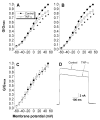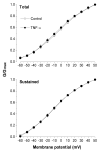Tumor Necrosis Factor-α Suppresses Activation of Sustained Potassium Currents in Rat Small Diameter Sensory Neurons
- PMID: 20165558
- PMCID: PMC2822358
- DOI: 10.2174/1876386300801010001
Tumor Necrosis Factor-α Suppresses Activation of Sustained Potassium Currents in Rat Small Diameter Sensory Neurons
Abstract
Tumor necrosis factor-α (TNF-α), a pro-inflammatory cytokine, produces pain and hyperalgesia by activating and/or sensitizing nociceptive sensory neurons. In the present study, using whole-cell patch clamp techniques, the regulation of potassium currents by TNF-α was examined in acutely dissociated small dorsal root ganglion neurons. We found that acute application of TNF-α inhibited, in a dose-dependent manner, the non-inactivating sustained potassium current without changing the rapidly inactivating transient current or the kinetics of steady-state inactivation. The effects of TNF-α on potassium currents were similar to that of prostaglandin E2 as reported previously and also demonstrated in the current study. Furthermore, indomethacin, a potent inhibitor for both cyclo-oxygenase (COX) -1 and COX-2, completely blocked the effect of TNF-α on potassium currents. These results suggest that TNF-α may sensitize or activate sensory neurons by suppressing the sustained potassium current in nociceptive DRG neurons, possibly via stimulating the synthesis/release of endogenous prostaglandins.
Figures







Similar articles
-
TNF-α acutely enhances acid-sensing ion channel currents in rat dorsal root ganglion neurons via a p38 MAPK pathway.J Neuroinflammation. 2021 Apr 14;18(1):92. doi: 10.1186/s12974-021-02151-w. J Neuroinflammation. 2021. PMID: 33853615 Free PMC article.
-
Prostaglandins suppress an outward potassium current in embryonic rat sensory neurons.J Neurophysiol. 1997 Jan;77(1):167-76. doi: 10.1152/jn.1997.77.1.167. J Neurophysiol. 1997. PMID: 9120557
-
NF-kappaB mediated enhancement of potassium currents by the chemokine CXCL1/growth related oncogene in small diameter rat sensory neurons.Mol Pain. 2009 May 28;5:26. doi: 10.1186/1744-8069-5-26. Mol Pain. 2009. PMID: 19476648 Free PMC article.
-
Acute P38-Mediated Enhancement of P2X3 Receptor Currents by TNF-α in Rat Dorsal Root Ganglion Neurons.J Inflamm Res. 2021 Jun 29;14:2841-2850. doi: 10.2147/JIR.S315774. eCollection 2021. J Inflamm Res. 2021. PMID: 34234509 Free PMC article.
-
Chronic exposure to tumor necrosis factor in vivo induces hyperalgesia, upregulates sodium channel gene expression and alters the cellular electrophysiology of dorsal root ganglion neurons.Neurosci Lett. 2017 Jul 13;653:195-201. doi: 10.1016/j.neulet.2017.05.004. Epub 2017 May 27. Neurosci Lett. 2017. PMID: 28558976
Cited by
-
TNF-α acutely enhances acid-sensing ion channel currents in rat dorsal root ganglion neurons via a p38 MAPK pathway.J Neuroinflammation. 2021 Apr 14;18(1):92. doi: 10.1186/s12974-021-02151-w. J Neuroinflammation. 2021. PMID: 33853615 Free PMC article.
-
Endothelin-1 raises excitability and reduces potassium currents in sensory neurons.Brain Res Bull. 2009 Aug 14;79(6):345-50. doi: 10.1016/j.brainresbull.2009.04.012. Epub 2009 May 3. Brain Res Bull. 2009. PMID: 19409452 Free PMC article.
-
TNF-α enhances sensory DRG neuron excitability through modulation of P2X3 receptors in an acute colitis model.Front Immunol. 2022 Aug 12;13:872760. doi: 10.3389/fimmu.2022.872760. eCollection 2022. Front Immunol. 2022. PMID: 36032155 Free PMC article.
-
Tumor necrosis factor-α enhances voltage-gated Na⁺ currents in primary culture of mouse cortical neurons.J Neuroinflammation. 2015 Jun 26;12:126. doi: 10.1186/s12974-015-0349-x. J Neuroinflammation. 2015. PMID: 26112872 Free PMC article.
-
Mechanisms of cancer pain.Front Pain Res (Lausanne). 2023 Jan 4;3:1030899. doi: 10.3389/fpain.2022.1030899. eCollection 2022. Front Pain Res (Lausanne). 2023. PMID: 36688083 Free PMC article. Review.
References
-
- Ahn SH, Cho YW, Ahn MW, Jang SH, Sohn YK, Kim HS. mRNA expression of cytokines and chemokines in herniated lumbar intervertebral discs. Spine. 2002;27:911–917. - PubMed
-
- Budde T, Mager R, Pape HC. Different Types of Potassium Outward Current in Relay Neurons Acutely Isolated from the Rat Lateral Geniculate Nucleus. Eur J Neurosci. 1992;4:708–722. - PubMed
-
- Chen DB, Yang ZM, Hilsenrath R, Le SP, Harper MJ. Stimulation of prostaglandin (PG) F2 alpha and PGE2 release by tumour necrosis factor-alpha and interleukin-1 alpha in cultured human luteal phase endometrial cells. Hum Reprod. 1995;10:2773–2780. - PubMed
-
- Creange A, Barlovatz-Meimon G, Gherardi RK. Cytokines and peripheral nerve disorders. Eur Cytokine Netw. 1997;8:145–151. - PubMed
Grants and funding
LinkOut - more resources
Full Text Sources
Research Materials
